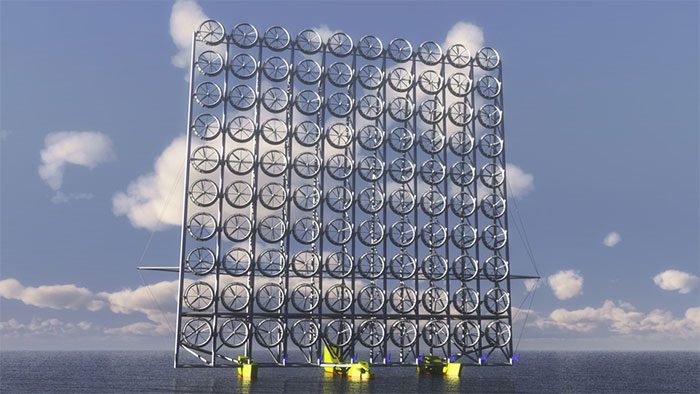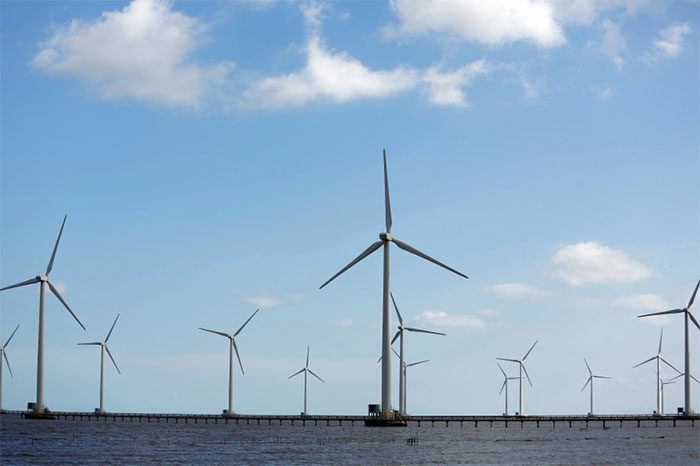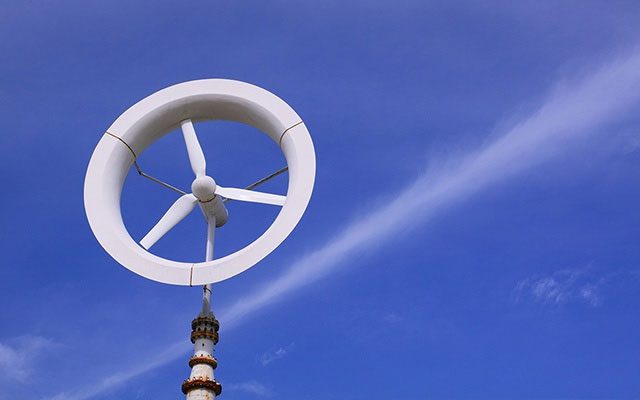Cluster wind turbines are emerging as a new offshore energy source. In this context, Kyushu University (Japan) plans to begin testing this type of turbine in 2028.
Amid growing concerns about climate change and energy security, researchers are racing to develop technology for offshore wind energy units consisting of multiple turbines.
Recently, the Offshore Wind Research and Education Center of Kyushu University has developed a new turbine design with a diffuser – functioning as a kind of “lens” to capture wind. The center also plans to construct a prototype unit comprising 100 small wind turbines, according to Nikkei Asia.

Cluster wind turbines are emerging as a new offshore energy source. (Photo: Kyushu University).
Cluster Wind Turbines
The power of a turbine increases in proportion to the swept area of each turbine blade. This is why turbine blades have been growing larger over the years. The largest operational turbine stands nearly 300 meters tall.
However, expanding wind blades to produce greater electricity output requires reinforcing the supporting tower, which is a costly endeavor.
Additionally, turbine blades rotate at speeds exceeding 100 meters per second. At such high rotation speeds, even raindrops can damage the blades upon contact. The noise generated by these massive, rapidly moving blades is also a concern.
In this context, cluster wind turbines mounted on a grid provide a viable solution, as their blades are designed to generate energy efficiently without needing to rotate quickly.
Moreover, placing turbines close together will have a multiplicative effect on efficiency. According to researchers, theoretically, a system of multiple turbines can produce more energy than a single traditional turbine of similar size.

Theoretically, a system of multiple turbines can produce more energy than a single turbine unit of similar size. (Photo: Reuters).
Kyushu University and Riamwind – a startup based in Fukuoka – are involved in a project to build a testing system consisting of two turbine units, each with a diameter of 25 meters, by 2024.
Data from this system will be used to construct another turbine system, which includes a support beam for 100 turbines arranged in a 10 x 10 format. With a height of approximately 230 meters and a width of 280 meters, the system is expected to generate 20 megawatts of electricity.
The turbines in this system will be smaller than traditional wind turbines and can be repaired individually. This means the system can continue generating electricity even if some turbines fail or are offline for maintenance.
This approach is attracting attention from investors worldwide. For example, Norwegian startup Wind Catching Systems plans to build a 300-meter-tall wind turbine consisting of a cluster of around 130 turbines, each with a diameter of about 30 meters.
The company claims that their floating technology could generate annual energy of up to 75 MW, five times more than the largest single turbines in the world.
More Efficient
Riamwind’s improved turbine technology features a diffuser at the circular blade area to focus wind energy. This relatively small new type of turbine, also referred to as a wind lens turbine, can generate energy more efficiently.
When wind hits the lens, it creates a vortex. This vortex forms a lower pressure area behind the turbine, further increasing the wind flow into the turbine and boosting wind speed.

Wind lens turbines generate 2-3 times more energy than conventional wind turbines of the same blade diameter. (Photo: Kyushu University).
Even a slight difference in wind speed can significantly increase output electricity. According to Riamwind, in tests, wind lens turbines produced energy 2-3 times greater than conventional wind turbines of the same blade diameter.
This type of turbine, with a diameter of several meters, has already been put into practical use. Yuji Oya, an emeritus professor at Kyushu University and head of Riamwind, stated that the energy capture efficiency per unit area swept by the new turbine is higher than any other wind turbine in the world.
Test results also confirm that this system generates less noise compared to turbines with the same output power. The vortices created by the small blades within the lens cancel each other out, helping to reduce noise.
The system is also less prone to bird strikes because the lens remains stationary.
However, one of the challenges with this design is the lens capturing wind along with the blades. Wind lens turbines face higher wind pressure compared to traditional turbine systems. This increases the risk of damage when exposed to extremely strong winds.
Riamwind is considering installing turbines or blades in a horizontal orientation to reduce wind pressure.
Another common challenge for cluster wind power systems is the high cost of the supporting grid.
Nevertheless, at a meeting in Sapporo in April, the G7 climate, energy, and environment ministers committed to increasing total offshore wind power capacity to 150 gigawatts by 2030. Achieving this ambitious goal requires advancing new wind energy technologies, including cluster turbines.



















































